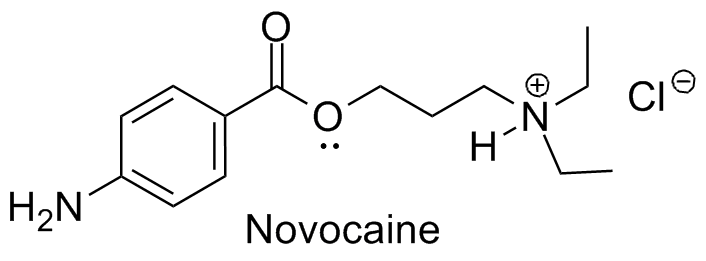Chapter 1.
Introduction
Benzocaine is the trade name for the local anesthetic known chemically as ethyl p-aminobenzoate, which is found in many creams and ointments used in the treatment of pain due to sunburn, minor burns, cuts, scrapes and insect bites. Benzocaine is structurally analogous to Cocaine, Lidocaine, and Novocaine (shown below) and is prepared by the esterification of p-aminobenzoic acid with ethanol.1 Esterification reactions can be significantly influenced by the concentration of starting materials and products in solution, as explained by Le Châtelier’s Principle.

Reaction

Lab Objective
To perform an esterification reaction using the procedure provided. The ester product should be purified by recrystallization and characterization carried out using m.p., Infrared spectroscopy, and Thin Layer Chromatography.
Procedure
Place 0.360 g of p-aminobenzoic acid and 3.60 mL of ethanol in a 10-mL conical flask. Add a magnetic spin vane and stir the mixture to dissolve the solid acid. While stirring, add 0.30 mL of concentrated sulfuric acid dropwise (CAUTION! sulfuric acid reacts violently with water, is a corrosive, and causes severe burns). Addition of sulfuric acid causes precipitation of the hydrogen sulfate salt of p-aminobenzoic acid, however this precipitate will dissolve during the following reflux period as the hydrogen sulfate salt of the acid is converted into the hydrogen sulfate salt of the ester. Check the acidity using pH paper to ensure that the reaction mixture is acidic. To prepare for reflux, attach a water-cooled condenser and heat the mixture so that it boils gently for 60–75 minutes.
When the reaction is complete, remove the reaction apparatus from the heat and allow it to cool. Using a Pasteur pipet, transfer the solution to a small Erlenmeyer flask containing about 3 mL of water. The reaction mixture should dissolve completely in the water, since the ethyl p-aminobenzoate is in the form of the hydrogen salt. After the solution has cooled to room temperature, add the 10% sodium carbonate solution dropwise to neutralize the cooled reaction mixture. As the pH of the solution rises, carbon dioxide will be produced and evolve as gas bubbles out of the solution. Continue to add the sodium carbonate until the gas evolution ceases and the pH is above 8. At this point, the sulfuric acid is completely neutralized, and the ethyl p-aminobenozate precipitates.
Collect the precipitated crude ethyl p-aminobenzoate by vacuum filtration using a Hirsch funnel. Use additional portions of water to aid in transferring the crystals to the funnel and wash the crystals with water on the funnel. Dry the cyrstals overnight and determine the melting point. Pure Benzocaine melts at 92 °C (here you can save a small sample to dry overnight for determination of the melting point and proceed with recrystallization of the bulk of the sample immediately). The crude benzocaine product can be recrystallized from a mixture of ethanol and water. Note a modification of fthe purification procedure may be necessary when isopropanol and tertbutanol are used rather than ethonol in the esterfication reaction as the expected products will exhibit slightly different solubility than benzocaine.
Techniques
Melting Point
Recrystallization
Gravity & Vacuum Filtration
Thin Layer Chromatography
Infrared Spectroscopy
Reagents
Compound | CAS Number | mol. wt. | Concentration | m.p. or | SAFETY |
|---|---|---|---|---|---|
p-aminobenzoic acid |
150-13-0 |
137.14 |
-- |
187–189 (mp) |
toxic, irritant |
Ethanol (anhydrous) |
64-17-5 |
46.07 |
200 proof |
78 (bp) |
flammable |
Concentrated H2SO4 |
7664-93-9 |
98.08 |
1.840 g/mL |
~ 290 (bp) |
corrosive |
Sodium Carbonate solution |
497-19-8 |
105.99 |
10% w/w aq |
-- |
toxic |
Isopropanol |
67-63-0 |
60.10 |
0.785 g/mL |
82 (bp) |
Flammable, toxic |
tert-butanol |
75-65-0 |
74.12 |
0.775 g/mL |
83 (bp) |
Flammable, toxic |
Ethyl 4-aminobenzoate (benzocaine) |
94-09-7 |
165.19 |
-- |
88–90 (mp) |
-- |
Isopropyl 4-aminobenzoate |
18144-43-9 |
179.22 |
-- |
85–86 (mp) |
-- |
tert-butyl 4-aminobenzoate |
18144-47-3 |
193.25 |
-- |
106–108 (mp) |
-- |